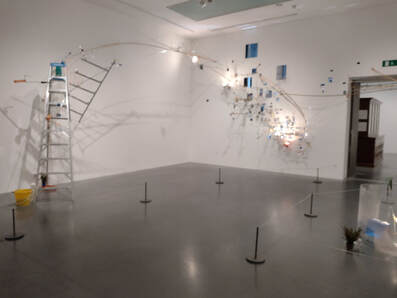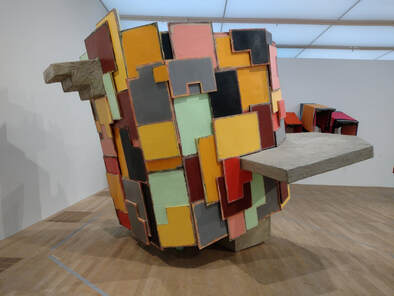- About
- Contact
- Blog
- CONSUME
- GALLERY
-
PERAMBULATIONS, Etc.
- Old Parcels Office, Scarborough
- Ghent
- White Cube
- Cornerhouse, Manchester
- Venice 2019
- Tectonics
- Leeds City Art Gallery
- Hayward Gallery, London
- Hull University Art Gallery
- Whitney Gallery, New York
- Royal Scottish Academy, Edinburgh
- Talbot Rice Gallery, Edinburgh
- Fruitmarket Gallery, Edinburgh
- Modern One & Two, Edinburgh
- Groeningemuseum, Bruges
- Humber Street Gallery, Hull
- Renwick Gallery, Washington DC
- Arenthuis, Bruges
- Ropewalk Gallery, Barton on Humber
- Geementmuseum, Den Haag
- Ferens, Hull
- Crescent Arts, Scarborough
- Walker Art Gallery, Liverpool
- Hepworth Wakefield
- Yorkshire Sculpture Park
- Stedelijk, Amsterdam
- Henry Moore Institute
- Louisiana
- SMK Copenhagen
- Yorkshire Sculpture International
- Tate Modern
- Whitworth, Manchester
|
Tate Modern
A general visit on the ‘collection route’ 13th December 2021 What some would describe as the ‘woke’ agenda (a word which the people who use it almost certainly don’t know what it means, except that it’s easier to pronounce than ‘political correctness’) is, likely to their horror becoming a significant feature at Tate Modern. Gallery after gallery reveals that yes, people of other than white ethnicity have produced art. The question of whether you like this art is for the birds, since the option to like or dislike a work of art has always existed. For those with a superior sense of their own aesthetic judgement it may be that ‘native’ art was always inferior to the Western canon. So what? So was Van Gogh, who never sold a picture and look where he is now. Having said all that I was not tempted to pop in to look at Lubaina Himid’s exhibition. Her paintings just don’t appeal to me. It’s like preferring one type of food over another I suppose. I would very much like to have immersed myself in Yayoi Kusama’s Infinity Mirror Rooms experience, but having failed to book a place the first time round when the limited availability tickets were marketed I gave up. Apparently I was 17,000th in the online queue, and when I got to 8,000th I was told the show had sold out for that cohort. But I could if I wished start all over again for the next cohort – from square one, not from my previous place in the queue. How crap, fuck it. Tate taking the piss. In the Blavatnik building in ‘Artist’s Rooms’ lurked the demolition site otherwise known as Phyllida Barlow’s creations. These generally ugly concoctions of cement, gunge and plaster are created on such a scale by Phyllida and her assistants you just can’t miss them. At least you wouldn’t accidentally trip over one of these pieces, even if they’re difficult to avoid. In the words of the Tate captioneer, they “interrupt and invade the space around them. They direct our movements and attention encouraging us to look at things in new ways.’ Well, so would a wall of breeze blocks blocking the entrance to the gallery, and such a thing would make you wonder what mystery lies behind the wall? What could it be that we’re not allowed to see? No such luck. As Phyllida says “the sculptural object is restless and unpredictable in how it can use space. It is not necessarily a comforting experience.” You could say that again, as visitors rapidly beat a retreat. The thing here is scale, make it big and you’re guaranteed a curator and fame. I wonder if Phyllida will one day be invited on to Celebrity Bake Off. Her cake, a huge formless mass would surely fill a warehouse and feed five thousand. On a small scale I was interested to see, in the exhibition called ‘A Year In Art: Australia 1992’ some etchings by Gordon Bennett (1955-2014). I wonder how an ‘aboriginal’ artist acquired such a name, but that’s irrelevant (he shared an Anglo/Saxon heritage too). These etchings, partly dealing with non-being and referencing suicide addressed the way in which aboriginal lives and culture were deemed not to exist by colonial powers. Hence the non-being, the denial of life, defined out of existence. Perhaps this non-beingness is akin to suicide. Meaning is defined by the reality of death. Perhaps this is what Derrida was talking about. But it could also be what Robert Hughes was talking about. He wrote “The Cultural Cringe is the assumption that whatever you do in the field of writing, painting, sculpture, architecture, film, dance or theatre is of unknown value until it is judged by people outside of your own society.” Except what Hughes was saying “most of the two-hundred year history of white Australia had bitten deeply into us and caused a reflex known as the Cultural Cringe.” (Nothing If Not Critical, Harvill Press, 2001, p4) Here then are the white Australians who are invisible, non-people. In today’s art world of course, the fate of many if not most artists is to reside in utter obscurity, non-beingness. In another gallery Sarah Sze takes over the space with a spindly, complex, fragile creation called Seamless. The title must be ironic, since it’s anything but seamless. It was first displayed in the US in 1999 and this is the first time it’s been set-up since, reconfigured to fit in this gallery. I wonder where all its bits have been stored in the meantime. Hopefully not near a Phyllida, where there would be a significant chance it could have been crushed. Anyway, what caught my eye was a glancing similarity to some work by Andi Dakin, recently reviewed on this site (see under Old Parcels Office). He too eyes up the space, and pays special attention to orifices from which things could emerge. In Sze’s case, square holes have been created in the walls for a similar approach. Andi also made use of step ladders, as has Sze. Is it fair to compare artists’ work? Probably not. But Tate does. On a wall in this gallery is Piet Mondrian’s Composition C (No.III) with Red, Yellow and Blue, 1935. This juxtaposition according to the caption “draws attention to Sze’s use of primary colours . . . which for Mondrian were the basic tools for painting. Mondrian’s use of grids is also echoed in the arrangement of holes cut into the wall.” On this basis, the middle of the room could perhaps have benefitted from the presence of a Donald Judd. Or maybe a late David Hockney, with all that colour painted on grids of panels! (I wouldn’t recommend Hockney climbing a stepladder these days to complete a single massive canvas. Not at his age.) Or perhaps a Howard Splodgkin, who’s colourful pictures are usually rectangular. The curator is spoilt for choice for specious connections. Actually, it might have benefitted from a juxtaposition with a Phyllida (see illustration above) – the heavy gravitational mass (yes, with its colours!) would have made something for Seamless to orbit, like a satellite. |


